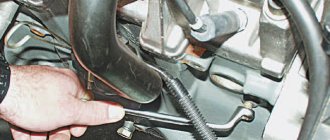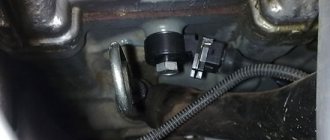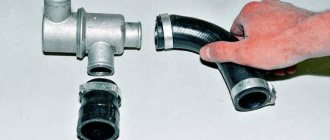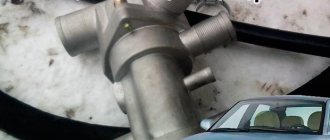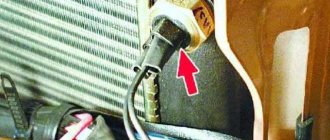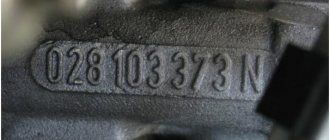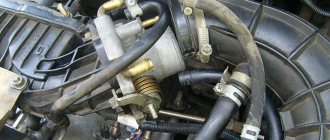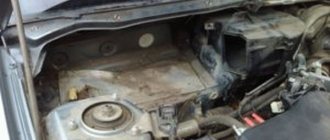A car thermostat for Lada Priora is a very small part that makes a big contribution to maintaining the temperature of the car. No matter how hot the car engine gets, its goal is to reduce the temperature by circulating fluid. The price of a standard thermostat is not high; as a rule, it costs around 500+ rubles. Replacing the thermostat of a Lada Priora car is a mandatory procedure if the car gets hot. In this case, it is necessary to change the thermostat, otherwise the engine will overheat. The part has analogues, but the standard part is the most effective. The Prior has 16 valves, replacement is a little more difficult, due to the fact that it is difficult to get to the antifreeze drain cap. The thermostat of the Priora car saves the engine from overheating. The part comes in 2 types: 1 - opens at a temperature of 92 degrees, 2 - at 95.
The thermostat on the Priora is a very simple device - what is most often damaged is what is inside: the cylindrical sensitive element. It is filled with a wax-based substance and therefore takes the ambient temperature well. The cylinder is surrounded by a spring, which is attached to a valve that tightly separates the small and large circles of circulation of the cooling system. When the material in the cylinder warms up to engine operating temperature, the spring expands and “pushes” the valve out. But this does not happen immediately: the valve extends fully only at a temperature of 103 degrees Celsius.
When the cooling effect of the liquid is achieved, the temperature (already reduced) is transferred to the filling of the cylinder, after which the spring is slowly compressed and the valve moves down. Thanks to the funnel effect, the coolant “drains” faster, and its volume in a small cycle remains unchanged - this is how the cooling system works.
The thermostat on the Priora is installed at the factory with the expectation that the engine will operate exclusively within the maximum permissible temperature. Its design is such that the thermostat (or rather, its valve) is designed to open at a temperature of about 98 degrees Celsius. An open valve provides a path for coolant into the radiator so that it cools even more - to an acceptable temperature - and circulates again, only this time in a large circle.
The factory thermostat of Lada Priora looks like this
What is a thermostat on Priora
The thermostat on the Priora is the main sensitive component of the car's cooling system. In a Lada Priora car, the thermostat is located between the engine and the radiator. Despite its small size, about 5 cm in diameter, it has two valves: bypass and main.
Replacing the thermostat on a Priora usually becomes necessary when the main valve malfunctions. It has a cylinder made of heat-sensitive material with a wax ball and rod inside. When heated above 82 degrees Celsius, the wax melts and expands, pushing the rod out. Thus the valve opens. And vice versa, when wax hardens, it decreases in volume. The valve closes. For a Priora car, the thermostat in the photo is shown in section. Its internal structure is shown.
The uninterrupted operation of the thermostat on the Priora keeps the engine temperature at a normal operating level. When the engine warms up, the Priora thermostat valve is closed, the opening temperature of which is 90-95 degrees. Accordingly, coolant does not flow to the radiator. The temperature in the system increases faster, engine wear and harmful emissions into the atmosphere are reduced, and your time and fuel are saved.
Methods for determining device malfunction
There are several ways to identify errors in the operation of the thermostat and eliminate the more serious consequences of its malfunction. For example, turn on the engine for a couple of minutes. If during this time the hose connecting the thermostat and the radiator manages to heat up, it means that there is a problem with the valve of the device. A hose of good design remains cold when the engine warms up briefly.
There are several ways to identify a thermostat malfunction, but it is best to seek help from a car mechanic.
There is another method to identify problems. The structure along with the thermometer is lowered into a special glass vessel with cold water. During the process of heating the water, it will become clear whether the unit is working properly or not. Sometimes a diagnostic scanner is used for such purposes.
To identify serious damage, it is recommended to seek help from specialists. They will help you resolve the problem in a timely and efficient manner.
How to check the thermostat on Lada Priora?
In order to verify that the thermostat is faulty, you need to perform a small test to confirm or refute the assumption that the thermostat is faulty.
- Start the engine and warm it up to operating temperature 85-90°.
- Then touch the lower radiator hose, it should not be hot or warm, it should be completely cold.
This is explained by the fact that the thermostat valve is in a closed state, therefore no coolant circulates through the pipe. Actually, this allows the engine to warm up faster, the coolant circulates in a small circle and heats up the engine faster. After the antifreeze temperature reaches a certain temperature (95-100°), the valve gradually opens, opening a large circle for coolant circulation, in which the radiator begins to “participate”. After the valve is open and the liquid flows in a large circle, the lower pipe will begin to heat up, that is, it will be hot. If you find that this is not the case and the pipe is hot even at a temperature of 70-80°, the thermostat is faulty and requires replacement.
Note: Sometimes the lack of coolant circulation is due to a faulty water pump, so it would be a good idea to check that too. How to check the pump, read this article and this one.
To replace the thermostat on a Priora, you will need a minimum set of tools and clean coolant.
Checking functionality manually
To make sure that the thermostat is the cause of engine overheating, do the following:
- Start the engine and wait until it warms up to operating values (85-90 degrees).
- Open the hood of the car and touch the radiator pipe. If its surface is warm or hot, this indicates problems with the cooling system. The fact is that a working thermostat begins to supply coolant in a large circle after the internal combustion engine heats up above 95 degrees. This was done in order to ensure the fastest heating of the engine to operating mode. After the valve begins to operate, the lower pipe heats up.
- If you notice that when the internal combustion engine heats up slightly, the pipe heats up, the reason is a faulty thermostat.
- Please note that in some cases the movement of cooling fluid is hampered by a faulty water pump, which is also a good idea to check.
Possible problems
Over time, the thermostat of a Priora car wears out and can be damaged. Since every time the car is started it is put into operation, the more often the car is in working condition, the more it is susceptible to breakdowns. As a result, it stops changing position and, in a broken state, takes either an open or closed position. This can be affected by mechanical damage, as well as loss of thermostat properties when the device ceases to control the temperature. It is possible that the valve will not close completely due to damage to the rubber gaskets. It is dangerous to operate such a car, so if it breaks down, it is recommended to replace the thermostat on the Priora with a new one.
The Lada Priora has 16 valves; when the device is not working, the following symptoms are noticeable on the car:
When the internal combustion engine constantly overheats, although the device is operating in normal mode, it is possible that the coolant is not passing through the radiator.
Due to coolant leakage, the device stops responding to temperature changes, and because of this, the engine will take much longer to warm up. If coolant gets on the element responsible for temperature control, the valve will open a little earlier and because of this there will be an oversupply. Thus, the cooling system may break down, and the engine will operate at higher speeds.
If the internal combustion engine starts to stall, then due to constant vibrations the coolant can come out and because of this the valve stops functioning.
Common causes of thermostat failure
Knowing them, the driver will be able to prevent more serious malfunctions in a timely manner.
- The power unit heats up for too long, even in summer. At the same time, tripping and general unstable operation of the engine are observed. This will cause the antifreeze temperature regulator valve to vibrate - after a while the seat may be damaged and the wax will leak out. This disrupts the operation of the device; the valve either does not close normally or does not open.
- Antifreeze got inside the thermostat. The overall volume of the regulator internals will increase, causing the valve to open prematurely.
- A special filler that reacts to temperature changes has leaked. As a result, the regulator will operate with a time delay.
And of course, various mechanical damage that occurs over time. In this case, the valve will also not open completely, and little antifreeze will flow into the radiator, which will lead to overheating of the internal combustion engine.
Thus, it will be possible to diagnose the condition of the thermostat using the above methods. It is not difficult to carry them out, but if any difficulty arises, contact professional mechanics at the service station.
How to solve a problem
Depending on the terrain in which the car is operated, it is necessary to choose which device is best to install on the Priora. If the installed device is suitable according to its parameters and characteristics, but the coolant exceeds the permissible values, then it is recommended to replace it with a similar spare part that has a higher temperature threshold for opening the valve. This approach is recommended for those who drive in mountainous areas or forests.
It happens that antifreeze stagnates in one place and this causes a plug to form. In this case, it is necessary to break through it. This can be done using a regular screwdriver.
If the valve opens prematurely, it is possible that the spring on the thermostat is weakened. In this case, you can tighten it or replace it with a new one.
When warming up the engine for a long time, it is best to check the rubber bands first. It is possible that the device is locked in the wrong position and will need to be secured in the correct position to normalize the air valve.
If the valve functions normally and opens on time, but the engine constantly overheats, then you first need to check the antifreeze level, as well as the possibility of plugging due to stagnation. It is possible that the radiator has stopped performing its functional duties and will need to be replaced. The problem may also lie in the fan or cooling pump. It is necessary to check their functionality and replace if necessary. The last thing that can interfere with good cooling is a dirty system. In this case, it is necessary to clean it.
Examination
Since problems with the device can arise at any time, the driver needs to know how to check it even in situations where it is not possible to get to a car service center.
The easiest way to check the thermostat is to leave it on. To do this, the internal combustion engine must be cooled down. We start the engine and at this time we need to touch the pipe, which is attached to the radiator. During the first few minutes, the radiator is not yet functioning, so the pipe should be cool. After this, wait until the engine warms up to operating temperature. Next you need to check the same pipe, it should be heated.
If the tube remains cold, then it is worth looking at what thermostat is used and replacing it with a similar one.
If the pipe heats up almost immediately, the engine will operate at lower temperatures. This problem is not critical, but because of this, gasoline consumption increases.
There is also a second way to check the device by dismantling it.
Before dismantling, you need to drain the antifreeze into a pre-prepared canister. After this, remove the thermostat, which is installed behind the pipe. We take the device and put it in a pan of water and put it on gas. At the same time, it should not come into contact with the walls. We lower the thermometer into the water and wait for the water to heat up to the operating temperature of the motor. When the temperature readings reach the required value, make sure that the valve changes from the closed position to the open position. If this does not happen, it is recommended to install a new device.
Replacing the thermostat on a Priora is not a complicated process that does not require special skills and can be diagnosed at home using improvised methods.
To replace, we need a Phillips screwdriver and a 10mm wrench to loosen the clamps, a 5mm hexagon, a hose, a watering can, a 5 liter bottle to drain the antifreeze, and a 1 liter bottle when unscrewing the far pipe. The leak will come from two places.
To make it easier to carry out all manipulations, remove the air filter housing (AF), take a slotted screwdriver to remove and return the rubber bands to the attachment points of the air filter housing. Next, simply unscrew the fastening nuts.
Before installing a new thermostat, check it using the methods indicated above; assembly is carried out in the reverse order.
But for more accurate diagnostics, it is recommended to contact specialized service centers that will perform their work efficiently and provide a warranty period for them.
All thermostat circles: signs of malfunction and what to do
As is known not only to motorists, but also to people who are quite far from cars, there is a mechanical device in a car called a “thermostat”, and it is connected to the cooling system.
Indeed, a thermostat is a mechanical valve whose main task is to regulate the coolant in the system. Among the main functions of the thermostat for which it is responsible are:
- warming up the engine to operating temperature (by timely redirecting coolant flows in a small or large circle);
- avoiding motor overheating;
- injection of warm air into the cabin.
Thus, as soon as the thermostat fails, the motorist will definitely feel it in one of two ways:
- the motor will begin to overheat;
- Cold air will blow from the heater because the engine is not warmed up
How to tell if the thermostat is broken: signs
Despite the fact that a faulty thermostat will not be the only cause of similar malfunctions both in the engine itself and problems with the stove and heating of the car interior, rest assured that in 60-70% of cases with similar malfunctions it will be this one.
Usually, under certain circumstances, they say that the thermostat valve is soured, either in the fully open or fully closed position, although, as a rule, there is some compromise: say, the thermostat valve is closed/not fully open, or it opens and closes earlier than expected time or delay, the seal is leaking, and so on.
Thus, in addition to the obvious signs, there are a couple more that indicate that the thermostat on your car has failed:
- The temperature sensor shows very high heating of the motor within the first 15 minutes after starting;
- On the contrary, the engine takes too long to warm up;
- The temperature fluctuates or rises too slowly, even in warm weather;
- Coolant leakage (liquid spilling in the form of drops is observed under the car or in the engine compartment) from under the thermostat housing.
Attention! Due to the fact that a thermostat failure can lead to engine damage (due to engine overheating, the geometry of the cylinder head is often disrupted), you should be attentive to the non-standard behavior of the car and not ignore warnings.
Before replacing the thermostat, check it (without dismantling, with dismantling)
Check without dismantling
The first option is the simplest. We start the engine, wait for the coolant temperature sensor needle to start moving (the engine starts to warm up), look under the hood (do not forget about precautions: remove long hair, scarves and other hanging clothing items so that they do not get into the moving elements of the engine) and Gently touch the radiator pipes with your hand, upper and lower.
If the lower pipe becomes warm in a short time after starting the engine (less than 2 minutes at a temperature of plus 20 degrees Celsius), this means that the thermostat is stuck in the open position - the coolant immediately flows through the large circuit. The coolant will take a long time to heat up, but the stove will not heat up.
If the thermostat remains in the closed position , the needle will quickly, in just a few minutes in the summer, go up to 90 degrees. The coolant circulates along a small circuit - inside the engine cooling jacket and through the heat exchanger of the stove. The engine will overheat very quickly.
With dismantling
But first of all, about safety: before dismantling the thermostat, you are strongly recommended to wear safety glasses and gloves. Now here's what else you'll need:
- Remove the thermostat (read below for how to do this);
- Find the temperature marking on the thermostat housing at which it should begin to open. Remember this temperature;
- Take a thermometer that can measure the temperature in boiling water;
- Then fill the pan with cold water. Place the thermometer in the pan and place it on the stove;
- Place the thermostat in a pan of cold water and turn on the stove;
- If the thermostat is working properly, then when the water reaches the temperature indicated on the thermostat body, it will begin to open. If this does not happen or the thermostat starts to come off when the water temperature reaches a higher temperature, then you will have to replace it with a new one.
What to do if the thermostat breaks? How to fix it? Need to change?
It will not be possible to repair it, only change it.
Luckily, this is a relatively simple repair that you can probably do yourself. And here is a set of easy to follow instructions.
- Drain bucket
- Set of wrenches
- Coolant
- New thermostat
- A level area to work on (such as a garage floor or driveway)
Here's what to do:
1. Let the car cool for 20-30 minutes (if it was started);
2. Find the thermostat. Locate the upper hose on the radiator and along it you will find the thermostat housing, which is connected to the engine;
3. Unscrew the coolant reservoir cap;
4. Drain the antifreeze, first placing a clean container down. As was said earlier, only part of the coolant can be drained, not completely. The main thing is that the level in the engine block is below the location of the thermostat valve.
There is a drain plug at the bottom of the radiator. Dirty coolant must be filtered before reuse;
5. Remove and replace the thermostat by unscrewing several mounting screws;
Causes of thermostat malfunction
Most often, the cause of thermostat failure is corrosion, scale and dirt that forms in the cooling system during operation. Particles of rust and scale are deposited on the thermoelement, as a result of which it loses sensitivity to changes in coolant temperature. Also, deposits interfere with the movement of the rod, which does not allow closing/opening the small/large circle in the cooling system. Therefore, in order to prevent such a scenario, fill in high-quality antifreeze and monitor its condition; during replacement, carefully inspect the bottom for the presence of “flakes” of rust or plaque. If the antifreeze is dirty, then the system requires flushing, as described here.
What reasons can cause a malfunction in the thermostat?
The main reasons why a thermostat fails are pollutants. The latter get inside the cooling system during vehicle operation. It could be:
- corrosion of metal;
- various deposits and scale that are deposited on the inner walls of the thermoelement;
- debris and dirt.
Over time, the amount of contaminants accumulates, which becomes an obstacle to the movement of the rod inside the cooling system.
To prevent this situation, you should monitor the quality of the antifreeze that is poured into the cooling system.
Checking the Thermostat
Most often, drivers notice a thermostat malfunction during the cold season. Since a car engine at low temperatures cannot heat up to operating temperature. Based on the fact that the engine temperature is below normal, the heater will not be able to heat the interior to a comfortable temperature.
The thermostat is checked on a cold engine.
We start the engine and touch the lower radiator pipe. It should be cold, not warm, but cold is very important. When the temperature reaches 85 degrees, the lower pipe should become hot. If the check on your car shows the opposite, then the thermostat is most likely faulty.
The thermostat will also be faulty if, when starting the engine, after some time the lower radiator hose becomes warm, then most likely the thermocouple is jammed or does not completely close the large circuit.
How to check the thermostat without removing it from the car? Signs of a bad thermostat
The thermostat is a small part in the mechanism of an internal combustion engine that is responsible for the operation of the cooling system. When this component stops working, thick accumulations of steam begin to emerge from under the hood of the vehicle, a similar picture can often be seen in various films and TV series.
The thermostat mechanically transfers flows of cooled liquid at different temperatures through the cooling system. It works in a large circle when the engine overheats - passing through the radiator, and in a small circle when the engine is cold - bypassing it. If this part does not work correctly, then in the cold season the stove freezes and it is impossible to warm up the car interior. There is a thermostat in both a used car and a new one, if they use a closed version of the liquid cooling system with forced circulation of liquid at a low temperature. The principle of operation of the part is identical for all cars, regardless of the country of manufacture.
Replacing the Priora thermostat is required if the following symptoms occur:
Unfavorable factors such as dirt in the coolant, scale, corrosion and metal flakes can cause the moving parts of the valve to stop working properly. It may also jam. The following signs may indicate this:
• The coolant temperature rises to operating level too slowly, taking longer than 10 minutes. This makes it clear that the valve is always open. Therefore, the coolant, circulating in a circle through the radiator, does not allow the engine to warm up.
• The engine heats up quickly, but the temperature becomes critical. This happens when the valve is closed, blocking the flow of coolant to the radiator.
Therefore, when choosing which thermostat is best for a Priora, do not forget about the coolant. It must be clean and of good quality.
Thermal inspection: how to check the thermostat without removing it from the car or when purchasing it in a store
Cold in summer is good. In winter, on the contrary, you want warmth, and more: both for the engine and for the interior. The problem cannot be solved without a thermostat, so they decided to introduce a thermal switch into the cooling system. The mechanism does not last forever, it serves as needed: some people take care of it for 40,000 km, others share their experience of trouble-free operation for 200,000 km. Failure will be marked by an undoubted violation of thermal equilibrium, and symptoms diagnosed at a time will indicate it.
When to change: signs of thermal switch failure
Abstract symptoms can indicate the nature of the disease that has befallen the thermostat:
- Stuck in the open position (coolant constantly circulates through the radiator). In cold weather, the engine does not heat up well, and at extreme city speeds the coolant temperature drops. Let's say it's -15°C outside, the coolant at idle has warmed up to 70°C, we're driving on a multi-lane road, moving at a speed of 60 km/h, and the temperature gauge needle is either standing still or going down. Fuel consumption increases noticeably (+ 1-2 liters per 100 km).
- The wedge is in the closed position (antifreeze moves along the jacket and heater radiator, bypassing the main heat exchanger). There will be no cooling and overheating is inevitable in summer. The fact is clearly clarified by the thermometer needle running upward when the cooling fan is on. Additionally, the “brains” indicate a problem in the form of an illuminated Check Engine icon.
- Final stop at an intermediate position. Prolonged heating + overheating in hot weather. Slight increase in appetite (within 1 l/100 km).
- It is impossible to close a large circle tightly, while the rod moves and the full opening occurs. There is no wedge. This is prevented by deposits accumulated as a result of untimely change of antifreeze, mixing coolant of different classes (for example, on a Hyundai Solaris, antifreeze can only be mixed with G11), and the use of cheap or counterfeit fluids. The fact can be revealed in warm weather only through tubes. In winter, pollution will be indicated by a reluctant rise in temperature from 70°C to 90-95°C when driving on the highway, but in the city there will be no problems with warming up. Seeing such a picture, those who like to cover the radiator grille with cardboard often persuade the owner to insulate the front end. This is definitely useful in cold weather.
Without removing it from the car: how to check the thermostat for serviceability using the engine radiator pipes
The main heat exchanger is connected to the engine cooling system by two hoses: inlet and outlet. The direct function of the thermostat is to connect/disconnect the heat exchange device by opening/closing one of the tubes at a temperature of 82-87°C. Which one is decided by the engine manufacturer.
Which hose should I touch?
Before you check the thermostat without removing it from the engine, you need to find out where it is installed: before the radiator or after it. This affects which pipe will be used to assess the regulator’s performance:
- Upper - in systems with a thermal switch located in front of the heat exchanger (for example, Lada Granta).
- Lower - in designs with a thermostat after the radiator (for example, VAZ 2110, Hyundai Solaris, Peugeot 308).
Norm and deviations
The diagnosis is made by the temperature of the hose. There are two methods for assessing it: approximate (by touch of the hand) and accurate (with a pyrometer). It is necessary to start diagnostics immediately after a cold start of the engine, examining the degree of heating of the upper or lower tube (depending on the thermostat layout):
- The tested hose was cold for some time, and the rest were hot, then became warm. If a pyrometer is used, at this moment the temperature of the pipe rises sharply to the point at which the thermostat opens. The thermostat switched the flow to a large circle. OK.
- The blocked tube immediately began to slowly warm up. The thermal switch is constantly open, and antifreeze circulates through the radiator when the engine is cold. Defective - stuck in an open, intermediate position or does not close completely.
- The hose being examined is constantly cold; according to the sensor on the dashboard, the temperature of the power unit has reached operating temperature. The thermostat is stuck in the closed position, the coolant constantly moves in a small circle. Defective.
At home: how to check the thermostat directly when purchasing in a store and before installing
There are plenty of defects, especially among Russian thermostats for VAZ. Unfortunately, there is no convenient way to fully test the node directly in the retail network. Holding a thermal device in your hands, the most you can do is blow into the fitting that opens access to the radiator. If no air flows, then the large circle is closed, which is what it should be at room temperature.
If the valve moves to the opposite position in which the flow moves through the heat exchanger, no one can tell when buying it in a store, and the thermostat will have to be checked at home. There is a point in this: if a defect is detected before installing the car, you won’t have to drain the coolant again and tighten the nuts. Diagnostics takes place in a pan pre-filled with cold water:
- Immerse the thermostat in water so that it does not come into contact with the walls of the container (hang it on a wire, the opposite end of which is secured to the crossbar).
- Place a thermometer calibrated to 100°C into the pan.
- Turn on the burner.
- Monitor whether the valve begins to open when approaching the thermostat response temperature (remove it from boiling water with pliers or lift it by a stick and see if water flows from the outlet).
- Make sure that the thermal switch completely switches to circulation in a large circle (water stops flowing from the other pipe).
Thermostat operating principle
The thermostat consists of a housing and a thermoelement. The main role is played by the thermoelement. The thermocouple is built into the housing and covers one of the holes in the thermostat cover. When the temperature reaches 85 degrees, the thermoelement opens.
Direct work on the car is that when the thermoelement is closed, the coolant circulates in a small circle, bypassing the engine cooling radiator; as soon as the coolant temperature reaches 85 degrees, the thermoelement opens and coolant circulation begins in a large circle through the radiator.
So during the entire operation of the engine, the thermoelement opens and closes a huge number of times.
Changing the thermostat on a Lada Priora with your own hands
Replacing steering tips on a VAZ 2114Important for motorists to know
The need to remove or replace the thermostat on a Lada Priora usually arises if it malfunctions or an antifreeze leak occurs. Malfunctions in the thermostat can be detected by characteristic signs, for example, when the engine takes a long time to warm up.
This is due to the fact that the thermostat does not close the large circulation circle in the cooling system, as a result, the warm-up time of a cold engine doubles, and at the same time fuel consumption. Sometimes the opposite happens, the thermostat does not open a large circle and the engine temperature reaches a critical point, after which the engine overheats.
Causes of thermostat malfunction
Most often, the cause of thermostat failure is corrosion, scale and dirt that forms in the cooling system during operation. Particles of rust and scale are deposited on the thermoelement, as a result of which it loses sensitivity to changes in coolant temperature. Also, deposits interfere with the movement of the rod, which does not allow closing/opening the small/large circle in the cooling system. Therefore, in order to prevent such a scenario, fill in high-quality antifreeze and monitor its condition; during replacement, carefully inspect the bottom for the presence of “flakes” of rust or plaque. If the antifreeze is dirty, then the system requires flushing, as described here.
How to check the thermostat on Lada Priora?
In order to verify that the thermostat is faulty, you need to perform a small test to confirm or refute the assumption that the thermostat is faulty.
- Start the engine and warm it up to operating temperature 85-90°.
- Then touch the lower radiator hose, it should not be hot or warm, it should be completely cold.
This is explained by the fact that the thermostat valve is in a closed state, therefore no coolant circulates through the pipe. Actually, this allows the engine to warm up faster, the coolant circulates in a small circle and heats up the engine faster. After the antifreeze temperature reaches a certain temperature (95-100°), the valve gradually opens, opening a large circle for coolant circulation, in which the radiator begins to “participate”. After the valve is open and the liquid flows in a large circle, the lower pipe will begin to heat up, that is, it will be hot. If you find that this is not the case and the pipe is hot even at a temperature of 70-80°, the thermostat is faulty and requires replacement.
Note: Sometimes the lack of coolant circulation is due to a faulty water pump, so it would be a good idea to check that too. How to check the pump, read this article and this one.
To replace the thermostat on a Priora, you will need a minimum set of tools and clean coolant.
Do-it-yourself replacement of the Priora thermostat - instructions
1. First of all, drain the coolant from the cooling system; to do this, unscrew the cap on the radiator.
2. Loosen the clamps securing the water pipes going to the thermostat, then remove them completely.
3. Unscrew the thermostat mounting bolts, and then remove the thermostat.
4. Remove the cover from the housing; to do this, unscrew its fastening bolts.
5. Take out the rubber gasket; it is located in a small recess in the thermostat cover. Check its condition and replace it with a new one if necessary.
6. Take out the mod (sensitive element), to do this, use pliers to slightly squeeze and turn the spring, removing the fixing plate from the hook with the grooves.
7. Before installing a new mod, check it. To do this, lower it into water and start heating. As it heats up, at approximately 85-90°C, the thermostat rod should begin to move out; if this does not happen, replace the sensitive element.
Note: If you don’t want to “mess around” with disassembling the thermostat, you can replace it as an assembly, but this will be more expensive.
Now that the Lada Priora thermostat has been replaced, all that remains is to fill in clean antifreeze and assemble the tool. Upon completion of the work, start the engine and check how the thermostat works according to the instructions described above. Make sure there are no leaks.
Thermostat Lada Priora: causes of malfunction, replacement instructions
A car thermostat for Lada Priora is a very small part that makes a big contribution to maintaining the temperature of the car. No matter how hot the car engine gets, its goal is to reduce the temperature by circulating fluid. The price of a standard thermostat is not high; as a rule, it costs around 500+ rubles. Replacing the thermostat of a Lada Priora car is a mandatory procedure if the car gets hot. In this case, it is necessary to change the thermostat, otherwise the engine will overheat. The part has analogues, but the standard part is the most effective. The Prior has 16 valves, replacement is a little more difficult, due to the fact that it is difficult to get to the antifreeze drain cap. The thermostat of the Priora car saves the engine from overheating. The part comes in 2 types: 1 - opens at a temperature of 92 degrees, 2 - at 95.
The thermostat on the Priora is a very simple device - what is most often damaged is what is inside: the cylindrical sensitive element. It is filled with a wax-based substance and therefore takes the ambient temperature well. The cylinder is surrounded by a spring, which is attached to a valve that tightly separates the small and large circles of circulation of the cooling system. When the material in the cylinder warms up to engine operating temperature, the spring expands and “pushes” the valve out. But this does not happen immediately: the valve extends fully only at a temperature of 103 degrees Celsius.
When the cooling effect of the liquid is achieved, the temperature (already reduced) is transferred to the filling of the cylinder, after which the spring is slowly compressed and the valve moves down. Thanks to the funnel effect, the coolant “drains” faster, and its volume in a small cycle remains unchanged - this is how the cooling system works.
The thermostat on the Priora is installed at the factory with the expectation that the engine will operate exclusively within the maximum permissible temperature. Its design is such that the thermostat (or rather, its valve) is designed to open at a temperature of about 98 degrees Celsius. An open valve provides a path for coolant into the radiator so that it cools even more - to an acceptable temperature - and circulates again, only this time in a large circle.
The factory thermostat of Lada Priora looks like this
Replacing the thermostat
To replace, you will need to drain the coolant.
Care must be taken to carry out work only on a cold engine to avoid burns.
Replacement Tool:
- Head or key set to “13”;
- Coolant 5 l;
- Clamps 50 mm;
- Hexagon on "6"
- Screwdriver “+” and “-”
Work process
- We remove the air filter box by unscrewing the clamp from the MAF sensor with a screwdriver and removing the chip from it. The box is held on by rubber clamps; in order for the box to be removed, you must forcefully pull it up.
- Drain the coolant. To do this, use your head or a key set to “13” to unscrew the plug on the cylinder block and drain the liquid into a container.
You can use old fluid only if it is clean; it is not recommended to refill dirty coolant.
- Loosen the front clamp of the large circle pipe on the thermostat cover (lower pipe from the radiator) and remove it.
- Loosen the rear clamp of the pipe on the thermostat cover (from the water pump tube) and remove it.
- Unscrew the 3 bolts securing the thermostat cover to the body with a hexagon to “6” and remove it.
- Install the new thermostat cover in reverse order.
- If the pipes are still old, it is recommended to use sealant to avoid coolant leaks.
After assembly, fill in the coolant, start the engine and let the car run for a few minutes, after which we check the coolant level again. Top up if necessary.
The thermostat replacement process is complete, there is nothing complicated about it. We hope our article was useful to you.
Best winter thermostat
There are very few manufacturers of thermostats with an increased element opening temperature. One of the most reliable and best companies producing them is LUZAR. It is this company that meets all quality standards in the manufacture of its parts.
Luzar thermostats are distinguished by their excellent workmanship, and they are also tested for accuracy of operation of the element up to 100%. Therefore, when purchasing a thermoelement from this company, you can be 100% confident in its efficiency and reliability.
They are tested in special cell-baths with temperature control; response speed, reliability and efficiency are checked. All elements that do not pass inspection are rejected and sent for revision, that is, it is almost impossible to run into a defective element.
Applicability
Luzar thermostat article number: 21082-1306010-92.
This element of the system is assembled with a cover and an o-ring, therefore, replacing it will not pose any difficulties.
Its cost is from 600 rubles and above, depending on the region and store.
Such a thermoelement is installed not only on the Lada Priora, but also on other Lada cars with an injection engine. All Lada modifications on which such a thermostat can be installed are shown in the table below.
Table of applicability of the LUZAR winter thermostat
The cooling system of a car is one of the main systems that ensures the possibility of its operation. The thermostat, in turn, is its most important component, and its malfunction can sometimes lead to considerable costs.
How will replacing the thermostat on a Priora save the family budget? Everything is trivial - when this device does not work, the engine may overheat. All this increases wear on the motor and, as a result, will lead to serious damage.
The price of a thermostat for Priora is low. Therefore, it is better to change it every two years. Knowing how to change the thermostat on a Priora, it’s quite possible to do it yourself. However, there are some peculiarities. Therefore, it would not be superfluous to have a little theory in order to decide which thermostat for the Priora is better.
How much does a thermostat cost on average for a Priora and what does the price depend on?
A car has long ceased to be an element of luxury. Its presence is a prerequisite if you need independence in movement both around the city and outside it. But before purchasing, many car owners do not think about how much vehicle maintenance may cost.
https://www.youtube.com/watch?v=JAr5mDyNl98
For example, the cooling system of a Lada Priora car requires considerable investment, especially when it comes to replacing the thermostat. The cost of this unit in Russia can vary from 500 to 1200 rubles , depending on the manufacturer and region of the country.
What is a thermostat?
The cooling system of any modern car and the Lada Priora in particular consists of several components. But the key in the design can safely be called the thermostat. Failure of the latter can significantly hit the car owner’s family budget.
The thermostat is a unit that ensures unconditional cooling of the engine while driving and idling. Failure to do so is fraught with dire consequences, such as engine overheating. The thermostat is located between the radiator and the engine. The dimensions of the part are quite small - only 5 cm , but this is quite enough to have two valves in it: the main and the bypass.
Most often, replacement of the unit is necessary when the main valve fails. If it does not operate adequately, the normal temperature readings of the engine are disrupted. Normally, the valve opening temperature should be 90-95 degrees . Then maximum fuel economy is achieved and engine wear is reduced.
What determines the price of a spare part?
Before you start searching and purchasing, you should understand in what situation a replacement is guaranteed. Incorrect operation may manifest itself in:
- Slow rise in temperature of the working fluid of the cooling system (more than 10 minutes)
- Very fast engine heating.
- The radiator hoses (one or all) are cold.
If one of the signs is present, we can talk about a malfunction. On the market you can find a fairly large number of offers for thermostats for the Lada Priora. The price in this case may vary. The reason lies in the material from which the spare part is made and in which factory it was produced.
Types of thermostats, their cost
Many car owners do not know which thermostat is best to choose. Experts recommend installing the standard version, the serial number of which is 21082-1306010-10 . On average, this option will cost about 1000 rubles .
Modification of the VAZ 2110 thermostat
If you decide to replace the thermostat with a new one, then at the same time you can immediately modify it
Modifying the thermostat has its pros and cons. In this article we will focus on how you can remake the VAZ 2110 thermostat yourself, and what you will need for this. Why are cars with a 6-hole thermostat warmer? They are warmer not because a sixth fitting has appeared there, but because the bypass channel has been reduced. And the new fitting serves to get rid of the constantly leaking heater return tee.
| Comparison of bypass channels of a 6-hole thermostat - 11mm (left) and 5-hole - 16mm (right) |
What does the bypass affect? Through the bypass channel, the coolant circulates in a small circle. And the smaller the diameter of the bypass channel, the more coolant flows through the heater. Since additional resistance is created when coolant flows in a small circle bypassing the stove. That is, by reducing the diameter of the bypass you increase the flow through the stove, that is, the car interior will be warmer.
Reducing the bypass channel for a 5-hole thermostat:
I would like to note right away that when the bypass channel in a 5-hole thermostat (TC) is narrowed, problems may arise: Problems associated with washing the thermoelement. That is, if in a 6-hole thermoelement the bypass coolant and the coolant of the outlet (cold) pipe of the stove are washed, then in a 5-hole thermocouple only the bypass coolant is washed. In order to reduce the bypass to the required value, you can cut a plate out of an aluminum plate. The plate must fit exactly inside , as shown in the figure. Next, the plate needs to be secured; for this you can use cold welding or rivets. Make sure that the rivets do not interfere with the closure of the small circle. Then we drill a new hole in the plate. Another fastening option.
Reducing the bypass channel for a 6-hole thermostat
Unlike the 5-hole TS, in the 6-hole TS I don’t see a single problem with narrowing the bypass! Because In addition to the bypass coolant, coolant from the heater also gets to the thermoelement. The technology for reducing the channel bypass is exactly the same here, except that we connect the heater return to the vehicle. For this fitting: What will be the difference after reducing the bypass? The difference will be that the temperature of the coolant reaching the thermoelement will depend on the percentage of coolant passing through the heater and passing directly through the bypass. And also from the drop in t in the heater radiator. If the drop in t in the heater radiator depends to a greater extent on the load on the radiator - the temperature of the outside air and the fan speed, respectively, then the percentage of the flows in question depends precisely on the diameter of the bypass. Accordingly, the stronger we If we reduce the bypass, the stronger will be the dependence of the engine t on the load on the stove.
Replacing the thermostat on a Priora - instructions
The replacement of the thermostat begins with the fact that the car must be driven onto an overpass. It’s easier to describe further steps step by step:
Open the hood, unscrew the cap (blue) of the expansion tank. Remove the engine protection;
- Get down under the car. Find bolt 13 - this is a plug for draining the coolant. It is not surprising that it is more difficult to get to it on a sixteen-valve engine than on an eight-valve one - after all, the design has changed. Take your time to remove the plug;
- Place a container (preferably a basin with a volume of at least 5 liters) under the plug, and only then unscrew it. Wait until all the antifreeze has drained, then tighten the bolt back. Check it several times, namely: tightness;
- Go up the overpass, and under the hood, at the top right above the engine, find the required part on the cylinder head. Using a Phillips screwdriver, unscrew the screws of the clamps holding the pipes and remove them;
- Using a hexagon, remove the thermostat cover bolts, and then the part itself. This element needs to be removed, but do not try to change the thermostat as quickly as possible - pay attention to the connection groove. It contains a rubber gasket, it can be cleaned of dirt and covered with automotive sealant;
- After the work has been done, you can install a new part in place of the old one, tighten the cover bolts and finish the work - put the pipes on the part, tighten the clamps (you can even put on new ones), pour sealant into the joint between them;
- Pour coolant into the reservoir. If a couple of days after the repair the machine consumes some liquid, this is normal - you just need to top it up to the normal level. Start the engine when warmed up (to about 75-80 degrees). At this time, check the integrity of the structure. Violation of tightness is unacceptable;
- If everything is in order, all that remains is to put back the engine protection and close the hood;
Replacing a thermostat on a Priora with a 16-valve engine is a little more complicated than on a Priora with an eight-valve engine. But, nevertheless, it can introduce the car owner to the route to the nearest overpass or pit, which will help out more than once - no one can rule out a breakdown.
Replacing the thermostat on a Priora
To perform the work you will need the following tools: — Key to “13”; — Screwdriver with a flat end; — Capacious container for liquid; - hex key.
- First of all, we install the car on a lift, overpass or over a garage pit.
- We move under the bottom of the car, remove the engine protection (if installed). On the block we find a drain plug made in the form of a “13” bolt. We prepare and place a deep sealed container under the drainage area. Using a wrench, unscrew the drain nut. We wait until all the liquid has drained. We tighten the bolt back.
- Let's move on to the engine compartment. We find the unit we need. It is located directly under the air filter pipe. Using a screwdriver, unscrew the screws of the clamps for the two large pipes and pull them off the assembly.
- We take the hexagon in our hands and unscrew the bolts securing the thermostat housing. We dismantle the product.
- We install a new device to replace the old one. When installing, pay attention to the rubber sealing gasket, which should not have cracks or other damage.
- We put on the pipes and tighten the clamps.
- Pour coolant into the expansion tank.
- Let's start the engine. We wait until the engine warms up to operating temperature and check the functionality of the system. The replacement procedure is the same for both 8-valve versions of cars and for 16-valve prior thermostats.
How to check for functionality
If all the described actions are not enough to determine the condition of the part, you can resort to experiment. As written earlier, to start working the part you need to feel the temperature of about 93-95 degrees. Why not replace the coolant with water?
The experiment can be carried out anywhere there is a kettle. After pouring approximately 300 ml of boiling water into a cup, you will have to wait 2 minutes, and then lower the “test person” into hot water. If it is working, then you can clearly study the principle of its operation. The rod of the part will begin a kind of movement, and the valve will rise to open the fluid communication through the large cycle.
Replacing the thermostat is not the easiest repair operation, but it is necessary so as not to “boil” in a traffic jam. It all depends on the choice of part and priorities. If you are too lazy to change it on time, engine wear will increase and, accordingly, its life will decrease.
Cost of replacement work
The standard thermostat of the VAZ 2170 Priora has catalog number 21082-1306010-10. When replacing, it is best to use a branded VAZ part, bypassing various types of analogues. As an alternative, you can use thermostats for other VAZ models with the following catalog numbers:
- 21082-1306010-11;
- 21082-1306010-12;
- 21082-1306010-14;
- 21082-1306010-15.
The thermostat is supplied with a 5mm hex key.
To be sure that the purchased thermostat is working, it is recommended to test it in hot water using the method described above before installing it.
The cost of a thermostat for a VAZ 2170 is about 500 rubles. The price for replacing it at service stations varies from 500 to 800 rubles.
Which thermostat is better to install on Priora
In order not to be tormented by the question of whether it will fit or not, it is much better to buy a standard Priora thermostat, the catalog number of which is 21082-1306010-10. Various analogues should not be used.
As a last resort, you can take a VAZ branded part from other car models. Check with the store that you are choosing a thermostat for a Priora. An experienced sales consultant will tell you which one is better.
In addition, the correct choice will be facilitated by knowing at what temperature the thermostat on the Priora opens. Starting to open at 83 degrees, the rod fully opens at 102 degrees Celsius. Take this into account when deciding which thermostat is best for the Priora if you decide to install something different.
Standard part - article number, price
The thermostat for the Lada Priora car is produced not only by the Volzhsky Automobile Plant - there is
cheap analogues, not at all pleasing with quality and durability. Compared to them, the price of a thermostat on a Priora with a 16-valve engine is not very high - about 500 rubles.
Quite a few remain who adhere to the theory that even an analogue can be better than the original; the main thing is to search well. The article number for this part for Priora must contain the following numbers - 21082-1306010-10.
How to replace a thermostat on a Priora
In order to successfully replace the thermostat in a Lada Priora car, you need to prepare. You should have clean coolant and tools on hand: a Phillips screwdriver, narrow-nose pliers and a five-point hex.
On a Priora car, the thermostat is replaced using the following algorithm:
1. Unscrew the cap on the radiator and drain the coolant.
2. To remove the Lada Priora thermostat, you will first have to loosen the clamps and disconnect the hoses that are attached to the thermostat cover.
3. Having previously unscrewed the bolts, remove the thermostat (Photo of the Priora and its engine compartment - see below).
4. Remove the thermostat cover bolts and pull it out.
5. Inspect the gasket located in the annular groove of the cover. If it is worn out, replace it.
6. Using pliers, pull out the mod. To do this, carefully clamp it, turn it and remove the fixing plate from the grooves.
7. We check the functionality of the new mod: heat it in a container with water. The pin should extend when the temperature reaches 90 degrees. Is this not happening? This means the mod is faulty.
8. We assemble the new thermostat in the reverse order. Do not forget to coat the joints of the pipes and the gasket on the cover with automotive sealant.
9. Pour clean antifreeze into the expansion flank of the engine up to about.
10. Warm up the engine, checking for leaks.
In the video, replacing the thermostat on a Priora is clearly shown.
The price of a Priora thermostat fluctuates around 500-1000 rubles. When choosing which thermostat is best for Priora, focus on workmanship, not cost. The new thermostat will allow the Lada Priora to delight you with uninterrupted operation.
Consequences of using a faulty thermostat
You cannot continue driving with a faulty thermostat. The engine will not warm up properly, and the flow of antifreeze will normally flow in large and small circles. This can cause a number of serious problems:
- overheating of the internal combustion engine with all the consequences;
- underheating of the engine, which will lead to worse fuel combustion and increased consumption, and the oil will grow a beard on the valves;
- antifreeze boiling in the expansion tank;
- failure of the entire cooling system, etc.
“One winter this happened to me. I’m driving home from a business trip, about 50 kilometers behind me. The track is flat, there is no snow, I move at a speed of 100-120 km/h. Well, I think why should it heat up, fifth gear, the fan cools it, that’s all. Suddenly I looked at the antifreeze reading arrow - below 40. This shouldn’t happen. It’s good that I stopped by the car service on time. The guys quickly determined the thermostat was faulty and replaced it with the original one. I also talked with the mechanics - they said that the open valve position is not so destructive for the engine, but fuel consumption increases and the valves become dirty. You’re lucky, they say it’s not stuck in the closed position, then the motor would have overheated and knocked.” Misha Kim, driver, Andreevsk.
